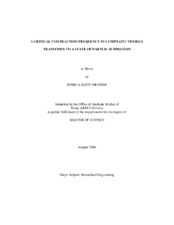| dc.description.abstract | Although lymphatic vessel behavior is analogous to hearts (e.g. systole and diastole) and blood vessels (e.g. basal tone), hearts and blood vessels have fundamentally different contractile properties. While summation during contraction is minimized in the heart, summation is necessary for tonic contraction in blood vessels. Because lymphatic vessel behavior mimics cardiac and vascular behavior, we hypothesized that above a critical contraction frequency there is significant summation, evidenced by significantly increased diastolic active tension (i.e. basal tone). We used an isovolumic, controlled-flow preparation to examine the interaction of contraction cycle-time with contraction frequency. Using segments of isolated lymphatic vessels (~1 cm in length and 3-4 mm in diameter) from bovine mesentery, we measured transmural pressure and diameter for end-diastole and end-systole during spontaneous contractions for 10 volume steps. We found time between contractions (beat-to-beat period) decreases with increasing diameter, and total contraction time (vessel twitch length, 11.08 ± 1.54 s) slightly increases with increasing diameter. At the intersection of these relationships, there is a critical period, below which the vessel does not have time to fully relax. Above the diameter at the critical period, diastolic active tension (end-diastolic minus passive vessel tension) significantly increases with increases in diameter (309 to 562% change in slope, p<0.0001), and, below the critical period, diastolic active tension increases with decreases in beat-to-beat period (712 to 2208% change in slope, p<0.0014). Because this transition occurs within a physiological range, it suggests summation may be crucial for lymphatic vessel function as a pump and a conduit. | en |


